Hyundai Elantra Dashboard Warning Lights
The Hyundai Elantra (also known as the Hyundai Avante in certain Asian markets) has been manufactured by South Korean car maker Hyundai since 1990. These Hyundai Elantra dashboard warning lights include both the gas / petrol and hybrid versions.
Dashboard design layout will vary depending on the model version of your Elantra and whether your model uses analogue or digital displays. The dashboard instrument cluster displayed above is from the Hyundai Elantra hybrid. Where the power gauge is displayed on the left, a tachometer will be displayed on non-hybrid versions.
Warning lights may vary depending on car manufacturer, but in general, red symbols represent the most urgent, with yellow symbols representing a less serious fault or maintenance issue. The recommended action to take is based on Hyundai’s recommendations.
Hyundai Elantra Hybrid Power Gauge
For the Hyundai Elantra Hybrid versions, this is an explanation of the power gauge. Display design of the power gauge varies depending on the model of vehicle.
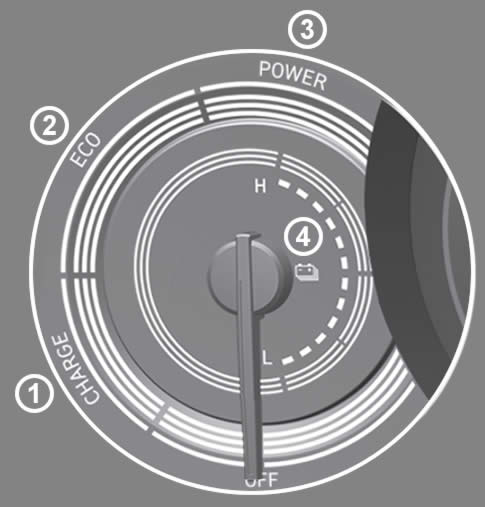
The power gauge (1 to 3) indicate if whether vehicle is being driven in a energy efficient manner.
- Charge: If the needle is within this section of the gauge, it means that the vehicle is regenerating energy and charging the battery.
- ECO: This section of the gauge indicates that the vehicle is being driven in an eco-friendly manner.
- Power: When the needle goes into this section, it means the vehicle is exceeding the eco-friendly range and is using high levels of energy / fuel.
- Remaining charge: The illuminated LED’s in this section display the remaining hybrid battery power. When the power level is near low (L), the engine is automatically operated to charge the battery.
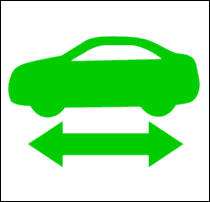 Hybrid Ready Light
Hybrid Ready Light
The Hyundai Elantra hybrid green ready light illuminates when the hybrid system has passed checks and the vehicle is ready to be driven. If the ready indicator light does not come on, it means normal driving is not possible or that a fault has occurred. If the ready indicator flashes, it means emergency driving only is possible.
 EV Mode Light
EV Mode Light
The Hyundai Elantra hybrid EV mode indicator light comes on when the vehicle is being driven purely by the electric motor, or that the gasoline engine has stopped. If the EV light is off, it means the vehicle is being driven by the gasoline engine.
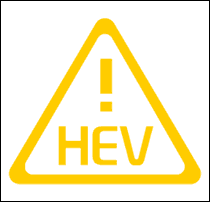 HEV Warning Light
HEV Warning Light
On the Hyundai Elantra hybrid, ‘HEV’ stands for hybrid electric vehicle and if the HEV warning light with exclamation point remains lit, or comes on while driving, it means there is a problem with the hybrid vehicle control system or hardware and the vehicle needs diagnostics. When the ignition is set to the ‘on’ position, the HEV warning light should go off after 3 seconds, when all hybrid system check have been completed and passed.
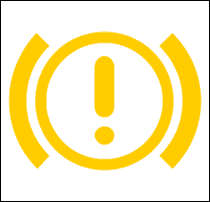 Regenerative Brake Warning Light
Regenerative Brake Warning Light
The yellow brake warning light applies to the Hyundai Elantra hybrid and comes on when a problem has been detected with the regenerative brake system. It means that the regenerative brake does not operate properly and the brake system does not perform as it should. The red brake warning light ![]() may also illuminate simultaneously. In this instance, your braking distance may increase. Have your vehicle checked by a Hyundai workshop immediately.
may also illuminate simultaneously. In this instance, your braking distance may increase. Have your vehicle checked by a Hyundai workshop immediately.
Hybrid and Non-hybrid Versions of the Elantra
The following warning light apply to both hybrid and non-hybrid versions of the Hyundai Elantra.
 Airbag Warning Light
Airbag Warning Light
Under normal conditions, the airbag warning light remains on for around 6 seconds when the ignition is set to on. After all checks have completed, the light should go off.
The Hyundai Elantra airbag warning light remains lit to warn that the airbag supplemental restraint system is not functioning. Reasons vary from a connector being dislodged, malfunctioning controller or an airbag impact sensor being damaged in the front or rear bumpers, or a worn, damaged clock spring. A capable scanner that can read airbag fault codes should help to isolate the problem.
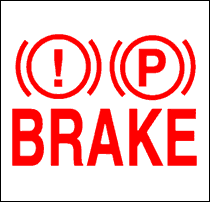 Brake Warning Light
Brake Warning Light
The Hyundai Elantra brake warning light illuminates for around 3 seconds when the ignition is switched to on. The brake light also remains lit if the parking brake is on. If the brake warning light remains lit when the parking brake is released, it means the brake fluid level is low. In this situation, safely stop the vehicle and check brake fluid levels along with any leaks in the brake system. Use only DOT4 brake/clutch fluid from a sealed container.
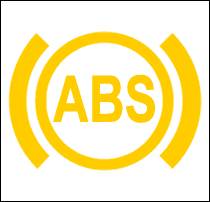 ABS Warning Light
ABS Warning Light
Almost all modern vehicles come equipped with a system that prevents the wheels from locking during heavy braking. This is called ABS (Anti-lock Braking System). The Hyundai Elantra is equipped with ABS and if the warning light remains constantly lit, or comes on while driving, it’s an indication that the ABS has a malfunction.
ABS problems are usually down to a damaged wheel speed sensor. In the event of a malfunctioning ABS, the vehicle’s brakes will continue to work as normal.
If the ABS ![]() +
+ ![]() brake warning lights come on simultaneously, it’s an indication that the vehicle’s Electronic Brake Force
brake warning lights come on simultaneously, it’s an indication that the vehicle’s Electronic Brake Force
Distribution (EBD) has failed. EBD improves the vehicle’s braking ability by distributing varying braking force to individual wheels.
 EPB Warning Light
EPB Warning Light
On the Hyundai Elantra, EPB stands for Electronic Parking Brake and should illuminate for around 3 seconds when the ignition is switched on, or when the electronic parking brake is applied. If the EPB light remains lit, even when the parking brake is released, it indicates a fault. In this instance, the best action is to have the EPB ECU scanned for fault codes with your Hyundai dealer.
 EPB Warning Light
EPB Warning Light
The Hyundai Elantra Auto Hold system works by automatically applying the last brake pressure that was applied by the driver when braking to a stop, meaning the driver can release their foot from the brake pedal without fear the vehicle will roll. The system uses wheel speed sensors to detect movement and if detected, greater brake pressure is applied. The brakes are automatically release when the gas pedal is pressed. The Auto Hold warning light has the following colors:
- White: Is illuminated when the Auto Hold system is switched on.
- Green: Is illuminated when the vehicle is stopped via the brake pedal and Auto Hold is applying brake pressure.
- Yellow: Is illuminated when a fault is detected with the Auto Hold system.
 Power Steering Warning Light
Power Steering Warning Light
As with most modern vehicles, electric power steering is used rather than hydraulic. The Hyundai Elantra electric power steering warning light remains lit when a fault has been detected. An electric fault either motor or circuit related, or torque sensor is likely. A competent diagnostic tool capable of reading the Elantra’s electric power steering (EPS) fault codes is essential. Overheating may cause a temporary fault.
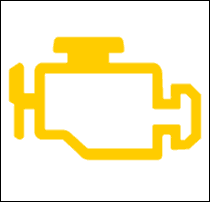 Engine Warning Light
Engine Warning Light
The engine warning light, also know as the ‘check engine’, or ‘malfunction indicator lamp’ (MIL) is synonymous with all gasoline and diesel engine vehicles. The Hyundai Elantra engine warning light remains lit when a problem has occurred with the engine, engine emissions control system or the vehicles’ powertrain.
The engine warning light is essentially generic and can potentially illuminate due to the malfunction of many of the vehicle’s components. If the engine warning light does come on, a fault code is usually generated and stored in the Elantra’s ECU. A diagnostic tool / fault code reader is then used to identify the malfunction. If your engine warning light comes on, the first step to take is to check for fault codes.
Although you can usually continue driving with the engine light on, continued driving over a longer time period may result in damage, particularly if the engine light is flashing. To minimize the risk of damage, the vehicle may enter reduced engine power mode.
More About the Engine Warning Light
For further information, see reasons why the engine warning light is on.
 Charging System Warning Light
Charging System Warning Light
The charging system warning light (battery warning light) will remain lit as an indication that the Hyundai Elantra’s battery is no longer being charged. If the light comes on while driving, immediately switch off any electrical accessories and avoid using any non-essential electrical equipment that will draw power from the battery.
In this instance, the fault is likely to be with the vehicle’s alternator, or drive belts. Check also that battery connections are free from corrosion and are fitted securely.
 Oil Pressure Warning Light
Oil Pressure Warning Light
Low engine oil pressure is harmful to internal combustion engines because it can prevent proper lubrication of internal components. If the Hyundai Elantra low oil pressure warning light comes on, engine power will automatically be reduced to help reduce damage. In this situation, stop as soon as possible and switch off the engine.
If the engine oil is low, top up using SAE 0W20 or ACEA C5. If you do not have oil, or the oil light remains on after adding oil, do not continue driving and arrange for vehicle recovery.
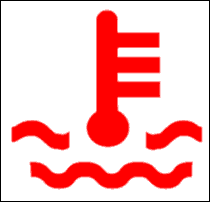 Engine Overheated Warning Light
Engine Overheated Warning Light
The engine overheated warning light comes on along with a message when the engine coolant temperature is above 120°C. In this instance, you may experience a loss of power. Pull off the road and shift the gear selector into Park (P) and set the parking brake. Ensure the air conditioner is switched off. If steam is coming from the engine, switch off the engine and contact a Hyundai workshop.
If steam is not coming from the engine compartment, leave the engine running and open the hood until the warning light goes off. If the warning light remains on, stop the engine and wait several minutes until checking coolant levels. Top up with coolant if required. For further information, see red engine coolant warning light on or flashing.
 Master Warning Light
Master Warning Light
The yellow triangle containing an exclamation point is the Hyundai Elantra master warning light. The master warning light may come on independently, with an additional warning light or with a message text. The master warning light may illuminate when there’s a problem with the following systems:
- Forward Collision-Avoidance Assist system
- Blocked radar of the Forward Collision-Avoidance Assist
- Blind-Spot Collision Warning system malfunction
- Blocked radar of the Blind-Spot Collision Warning radar
- High Beam Assist
- External lights
- Smart Cruise Control
- Tire Pressure Monitoring System (TPMS)
The Elantra’s radar is located on the vehicle’s front grille. Ensure the area is clean and clear of debris.
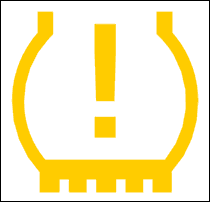 Tire Pressure Warning Light
Tire Pressure Warning Light
The Hyundai Elantra tire pressure warning light comes on when one or more tires is underinflated, or if the warning light flashes initially for around one minute then remains lit, it means there’s a fault with the Tire Pressure Monitoring System (TPMS).
If the tire pressures are low, inflate in accordance to the cold tire pressure label located on the driver’s side center pillar outer panel. After adjusting the pressures, the tire pressure monitor will automatically reset after the vehicle has been driven at speeds above 16 mph for more than 20 minutes.
A TPMS fault (flashing light) is usually due to a tire not being fitted with a pressure sensor (such as the spare) or a sensor has been damaged. Additionally, electronic equipment can interfere the the TPMS radio signal.
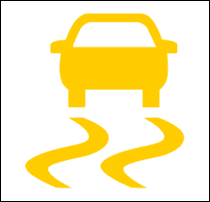 ESC Warning Light
ESC Warning Light
ESC (Electronic Stability Control) is a stability safety system fitted to almost all modern vehicles. Its purpose is to help reduce understeer, oversteer and to increase the traction of the vehicle’s tires (traction control). If the ESC light flickers or flashes, the system is operating and attempting to stabilize the vehicle.
If the ESC light remains constantly lit, it means the system either has a fault, or is disabled. An ESC fault usually occurs dur to a malfunctioning wheel speed sensor. Additionally, it’s quite common for the ESC light to illuminate alongside the engine warning light. This is often due to ESC being automatically disabled when another fault has occurred (engine light) and to prevent interference from the ESC system. For more information, see What ESC is in cars and How does ESC work in cars.
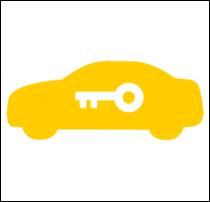 Immobilizer Warning Light
Immobilizer Warning Light
Under normal operating conditions, the Hyundai Elantra immobilizer warning light should come on when the vehicle detects the electronic key with the ignition switch in the ‘on’ position. Under these conditions, the engine can be started. The immobilizer light should go off once the engine has started.
If the immobilizer warning light flashes, it’s an indication of a fault with the immobilizer system. Hyundai Elatra immobilizer problems can relate either to the electronic key transponder or the receiver that reads the signal from the chip in the key.
First try an alternative key if you have one, or replace the battery inside the key fob. Occasionally, the key may need to be replaced or reprogrammed. Problems can also be common with the immobiliser antenna ring / key reader coil.
 Lamp Warning Light
Lamp Warning Light
This warning light comes on when one of the vehicle’s exterior bulbs, including the headlight bulbs, daytime running lights, turn signals, side lights, stop lights or licence plate lights have failed. If your version of Elantra has LED headlights, this warning light will also come on or flash.
 Particulate Filter Warning Light
Particulate Filter Warning Light
This warning light comes on when either the diesel or petrol particulate filter requires regeneration. Regeneration is required when the filter becomes saturated with fuel soot and is usually an automatic process. Filters are more prone to blockage on diesel version where the vehicle is mainly used for short trips.
To regenerate the filter, take an extended drive, usually for 20 to 30 minutes, ideally on a highway that does not require stopping. If the light remains on, the vehicle may need a forced regeneration which can be performed at a vehicle workshop.
 External Temperature Warning Light
External Temperature Warning Light
The Hyundai Elantra snowflake symbol is the external temperature warning light. It comes on to warn the driver that external temperatures are below 4°C and that there’s a risk of slippery ice on the roads. In this instance, drive with care and avoid sharp braking and turning.
Driving Assistance Systems
The Hyundai Elantra’s driving assistance systems such as Forward Collision Avoidance Assist (FCA), Lane Keeping Assist (LKA), Blind Spot Collision Avoidance Assist (BCA), Safe Exit Assist (SEA) and Driver Attention Warning (DAW) use a variety of sensors to operate.
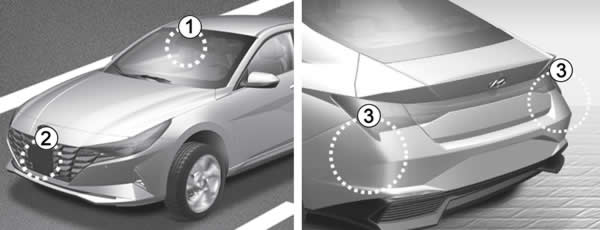
Always ensure the windshield is clean and free from mist so that the camera sensor located under the rear view mirror (1) can operate efficiently. The radar (2) located on the vehicle’s front grille can become dirty and may require cleaning. The sensors located in the vehicle’s rear bumper (3) should be kept clean of dirt.
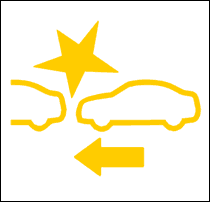 Forward Collision Assist Warning Light
Forward Collision Assist Warning Light
The Hyundai Elantra’s Forward Collision Avoidance Assist (FCA) is a safety system that can detect vehicles and pedestrians ahead and warns the driver of an imminent collision, either by warning light and audible warning. The system can also apply emergency brake.
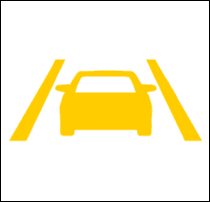 Lane Keep Assist Warning Light
Lane Keep Assist Warning Light
The Hyundai Elantra’s Lane Keeping Assist (LKA) detects lane lines and helps to keep the vehicle within its lane by warning the driver if the vehicle deviates from the lane without the driver applying a turn signal. The LKA warning light has different meanings based on its color:
- Green: Is when LKA is activated
- White: Is when LKA is operating but conditions are not suitable
- Yellow: Is when there’s a fault with the LKA system
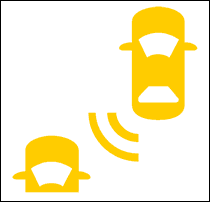 Blind Spot Monitoring Warning Light
Blind Spot Monitoring Warning Light
The Hyundai Elantra’s Blind Spot monitoring system uses sensors located in the vehicle’s rear bumper to monitor traffic in the driver’s blind spot. The system warns the driver if it detects an impending collision either by use of warning light, message and audible alert.
 Driving Modes
Driving Modes
The Hyundai Elantra’s Smart mode combines ECO, Normal and Sport modes and by judging the driver’s style adapts the vehicle accordingly.
Sport mode alters steering characteristics and enhances the engine and transmission for a more responsive drive. A reduced fuel economy may apply when in sport mode.
In ECO mode, gear shift patterns are altered and overall engine speed reduced. In ECO mode, you may notice that acceleration is a little slower.
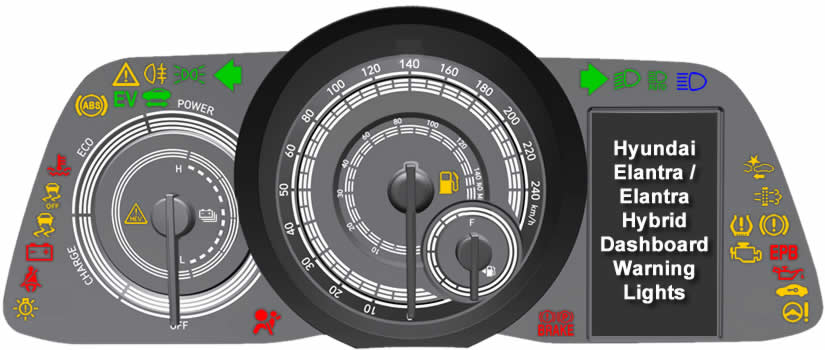
What about CUP + STEAM?
I think that symbol is informing you that you’ve been driving for a long time and need a break.
Can an owner turn off some of the audible or iluminated warnings? eg “take a break” or the lane assist warnings with the the steering wheel pulling to one side or the other ?